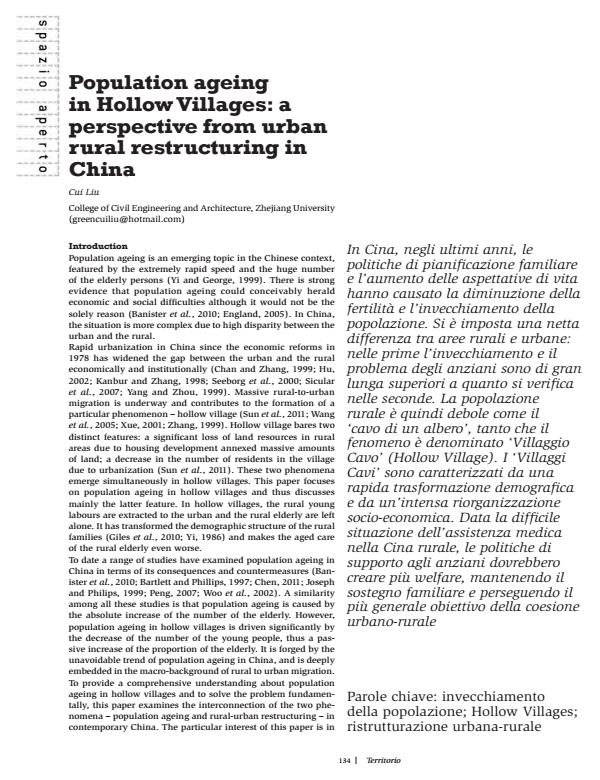Population ageing in Hollow Villages: a perspective from urban rural restructuring in China
Titolo Rivista TERRITORIO
Autori/Curatori Cui Liu
Anno di pubblicazione 2014 Fascicolo 2014/69
Lingua Italiano Numero pagine 9 P. 134-142 Dimensione file 296 KB
DOI 10.3280/TR2014-069019
Il DOI è il codice a barre della proprietà intellettuale: per saperne di più
clicca qui
Qui sotto puoi vedere in anteprima la prima pagina di questo articolo.
Se questo articolo ti interessa, lo puoi acquistare (e scaricare in formato pdf) seguendo le facili indicazioni per acquistare il download credit. Acquista Download Credits per scaricare questo Articolo in formato PDF

FrancoAngeli è membro della Publishers International Linking Association, Inc (PILA)associazione indipendente e non profit per facilitare (attraverso i servizi tecnologici implementati da CrossRef.org) l’accesso degli studiosi ai contenuti digitali nelle pubblicazioni professionali e scientifiche
In Cina, negli ultimi anni, le politiche di pianificazione familiare e l’aumento delle aspettative di vita hanno causato la diminuzione della fertilità e l’invecchiamento della popolazione. Si è imposta una netta differenza tra aree rurali e urbane: nelle prime l’invecchiamento e il problema degli anziani sono di gran lunga superiori a quanto si verifica nelle seconde. La popolazione rurale è quindi debole come il ‘cavo di un albero’, tanto che il fenomeno è denominato ‘Villaggio Cavo’ (Hollow Village). I ‘Villaggi Cavi’ sono caratterizzati da una rapida trasformazione demografica e da un’intensa riorganizzazione socio-economica. Data la difficile situazione dell’assistenza medica nella Cina rurale, le politiche di supporto agli anziani dovrebbero creare più welfare, mantenendo il sostegno familiare e perseguendo il più generale obiettivo della coesione urbano-rurale
Parole chiave:Invecchiamento della popolazione; Hollow Villages; ristrutturazione urbana-rurale
- Sustainable Transformation in China’s Agricultural Sector: From Traditional Narrow Patterns to Smart Dynamic Production John C.G. Lee, Se Tin, Juniati Gunawan, in Foresight and STI Governance /2024 pp.6
DOI: 10.17323/2500-2597.2024.3.6.15
Cui Liu, Population ageing in Hollow Villages: a perspective from urban rural restructuring in China in "TERRITORIO" 69/2014, pp 134-142, DOI: 10.3280/TR2014-069019